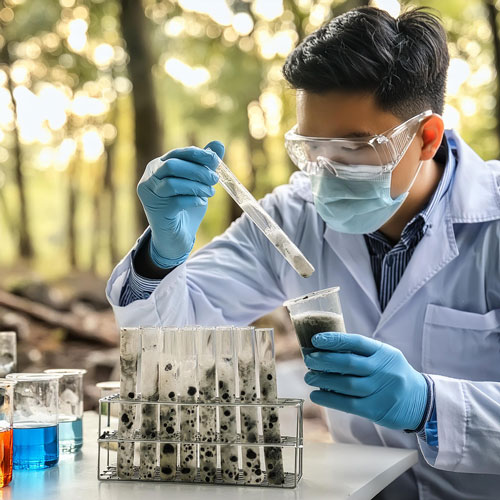Mold tests and remediation are ways to find and get rid of mold growth in buildings and homes so that they are healthy places to live. A quick look at each step is given below:
Testing for mold
Mold testing is the process of finding mold in a building and figuring out what kind of mold it is and how much of it there is. Here are the main steps you need to take:
Visual Inspection: Look around the property for mold growth, water damage, and other problems with wetness.
To find secret dampness, use tools like moisture meters.
Collection of Samples:
Air Sampling: Take samples of the air from different parts of the house to look for mold spores in the air.
Samples from the Surface: Use a swab or tape to take samples from areas where mold growth can be seen.
Bulk Sampling: Get pieces of materials (like drywall or insulation) that have mold on them to test in the lab.
Laboratory Analysis: Take the samples you’ve collected to a lab so they can figure out what kind of mold is there and how much of it there is.
These results help figure out how bad the mold problem is and how to fix it.
Evaluation and Reporting: A full report is given that describes the results, the type of mold found, and the suggested steps for cleaning up the area.
Cleaning up mold
Mold remediation is the process of getting rid of and cleaning up moldy places so that the environment is safe again. These are the main steps:
Safety and Containment: Do not let mold spores spread to parts of the building that are not affected by them. Instead, seal off the affected areas.
Wear safety gear like masks, gloves, and goggles to keep yourself safe during the cleanup.
Getting rid of moisture: Find and fix the source of the water that is causing mold to grow, like leaks or bad airflow.
Dry out the places that need it with dehumidifiers and fans.
Getting rid of things that are moldy:
Porous materials that can’t be cleaned, like walls, carpeting, and insulation, should be taken away and thrown away.
Use the right cleaning products to clean and disinfect non-porous surfaces like metal and glass.
In order to clean and disinfect, you should use special cleaning products to get rid of mold.
You can get rid of mold spores and dust from objects and the air by vacuuming with HEPA.
Repair and Restoration: Put in new materials that won’t grow mold where the old ones were.
Fix any damage to the building that mold growth caused.
Verification after remediation: Do a follow-up inspection and mold tests to make sure that the remediation worked and that the mold levels are now acceptable.
Why professional help is important
Small mold problems can sometimes be fixed by the individual, but big mold problems need to be fixed by a professional to make sure it’s done right and safely. Mold tests and removal are best done by professionals who have the right training, tools, and experience.
Mold testing and removal are important parts of keeping a living space healthy, especially in places that have had water damage or ongoing problems with wetness. Correct testing finds the amount and type of mold present, while treatment gets rid of the mold and stops it from growing again. Taking care of mold problems quickly can keep people healthy and keep buildings from getting damaged.

